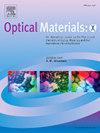Evaluation of the optical, structural, morphological and electronic properties of Rb3Bi2I9 Perovskites films prepared by Sequential Evaporation
Q2 Engineering
引用次数: 0
Abstract
Toxicity and poor stability remain major barriers to large-scale production of hybrid organic-inorganic lead halide perovskite solar cells. Considering the isoelectronic nature of lead (II) and bismuth (III) ions, stable and non-toxic alternatives for developing photovoltaic devices could potentially be found. Rb3Bi2I9 perovskite films inherently suffer from unavoidable pinhole defects and poor surface morphology, which limit device performance. In this work we explored a dual-source thermal sequential evaporation approach to growth uniform and pinhole-free morphology of Rb3Bi2I9 polycrystalline thin films. The influence of post-deposition annealing in a high-pressure N2 atmosphere on the structural, optical, morphological, and electronic properties of the resulting films was studied experimentally using X-ray diffraction (XRD), optical spectrophotometry, scanning electron microscopy (SEM), and computationally via Density Functional Theory (DFT) calculations. The results revealed that post deposition annealing significantly improves both the morphology and degradation processes of Rb3Bi2I9 films, when they are exposed to environmental conditions for long periods of time.
对顺序蒸发法制备的 Rb3Bi2I9 Perovskites 薄膜的光学、结构、形态和电子特性的评估
毒性和稳定性差仍然是阻碍有机-无机卤化铅钙钛矿混合太阳能电池大规模生产的主要障碍。考虑到铅(II)和铋(III)离子的等电子性质,可能会找到稳定且无毒的光伏器件替代品。Rb3Bi2I9钙钛矿薄膜本身存在不可避免的针孔缺陷和较差的表面形貌,这限制了器件的性能。在这项工作中,我们探索了双源热顺序蒸发方法来生长均匀和无针孔的Rb3Bi2I9多晶薄膜。利用x射线衍射(XRD)、光学分光光度法、扫描电镜(SEM)和密度泛函理论(DFT)计算,研究了高压N2气氛下沉积后退火对薄膜结构、光学、形态和电子性能的影响。结果表明,当Rb3Bi2I9薄膜长时间暴露在环境条件下时,沉积后退火显著改善了薄膜的形貌和降解过程。
本文章由计算机程序翻译,如有差异,请以英文原文为准。
求助全文
约1分钟内获得全文
求助全文
来源期刊

Optical Materials: X
Engineering-Electrical and Electronic Engineering
CiteScore
3.30
自引率
0.00%
发文量
73
审稿时长
91 days
 求助内容:
求助内容: 应助结果提醒方式:
应助结果提醒方式:


